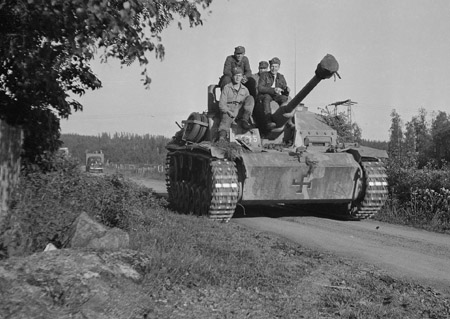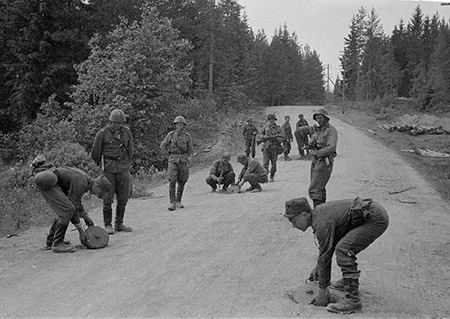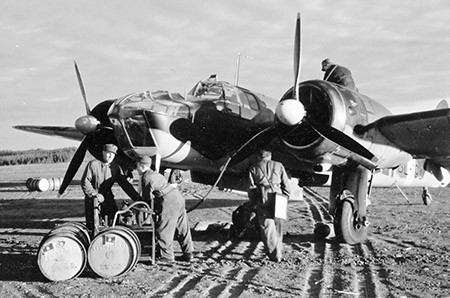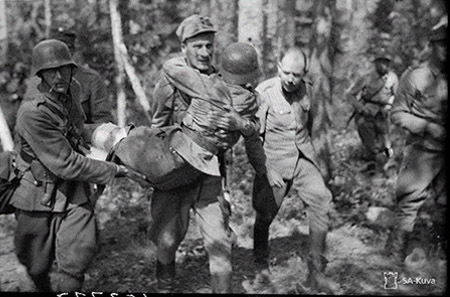Click to access the museum-specific section
Military MuseumMuseum Militaria
Finnish Air Force Museum
The Museum of Military Medicine
Overview
The Allies decided to force Finland to break away from its alliance with Germany in the summer of 1944. The Red Army carefully prepared for a major offensive on three fronts, where the Finns were engaged in a static phase of warfare. The meticulously planned major offensive by the Leningrad Front, known as the Vyborg Operation, began on June 10, 1944, on the Karelian Isthmus. Although the attack at Valkeasaari did not surprise the frontline troops, its exact timing and intensity did. The higher command had been reluctant to believe in the imminent attack. Just four days later, the Russians breached the Finns' strongest defense line at Kuuterselkä, and ten days after the offensive began, Vyborg was lost.
The attack on the Karelian Front in Olonets began on June 21, at Lotinapelto. By this time, the main Finnish forces had already begun their withdrawal, initially to the Pisi–Saarimäki–Sammatus line. The skillful Russian landing at Tuulos on June 23 significantly complicated the Finnish retreat along the Ladoga coastal road towards Nietjärvi. On the Maaselkä Isthmus, the planned Finnish withdrawal began on June 20, and by mid-July, fighting had reached the rear defensive line.
The Germans on the Eastern Front had realized that a Russian offensive in the direction of the main thrust would always lead to a breakthrough. The Finns learned this lesson on the Isthmus in 1944. After a 100-kilometer withdrawal, the defense of all arms and branches succeeded in repelling the Russians at the rear defensive positions with the help of reserves arriving from Olonets. The defense was successful in Vyborg Bay, Tienhaara, Juustilankangas, Ihantala, north of Tali, Noskua, and Vuosalmi.
The concentrated artillery fire and the improved anti-tank capabilities, thanks to new weapons like the Panzerfaust and Panzerschreck, strengthened the infantry's confidence in their own capabilities on the main fronts. The support from Germany, particularly its air force, was also significant. The rear defensive battles began in the northeastern corner of Lake Ladoga at Nietjärvi on July 11 and simultaneously to its north up to Loimola. The last major battle took place in early August at Ilomantsi, where the assembled troops achieved a significant victory.
The attack on the Karelian Front in Olonets began on June 21, at Lotinapelto. By this time, the main Finnish forces had already begun their withdrawal, initially to the Pisi–Saarimäki–Sammatus line. The skillful Russian landing at Tuulos on June 23 significantly complicated the Finnish retreat along the Ladoga coastal road towards Nietjärvi. On the Maaselkä Isthmus, the planned Finnish withdrawal began on June 20, and by mid-July, fighting had reached the rear defensive line.
The Germans on the Eastern Front had realized that a Russian offensive in the direction of the main thrust would always lead to a breakthrough. The Finns learned this lesson on the Isthmus in 1944. After a 100-kilometer withdrawal, the defense of all arms and branches succeeded in repelling the Russians at the rear defensive positions with the help of reserves arriving from Olonets. The defense was successful in Vyborg Bay, Tienhaara, Juustilankangas, Ihantala, north of Tali, Noskua, and Vuosalmi.
The concentrated artillery fire and the improved anti-tank capabilities, thanks to new weapons like the Panzerfaust and Panzerschreck, strengthened the infantry's confidence in their own capabilities on the main fronts. The support from Germany, particularly its air force, was also significant. The rear defensive battles began in the northeastern corner of Lake Ladoga at Nietjärvi on July 11 and simultaneously to its north up to Loimola. The last major battle took place in early August at Ilomantsi, where the assembled troops achieved a significant victory.





